ESP Lancia Ypsilon 2020 Owner handbook (in English)
[x] Cancel search | Manufacturer: LANCIA, Model Year: 2020, Model line: Ypsilon, Model: Lancia Ypsilon 2020Pages: 200, PDF Size: 4.53 MB
Page 150 of 200
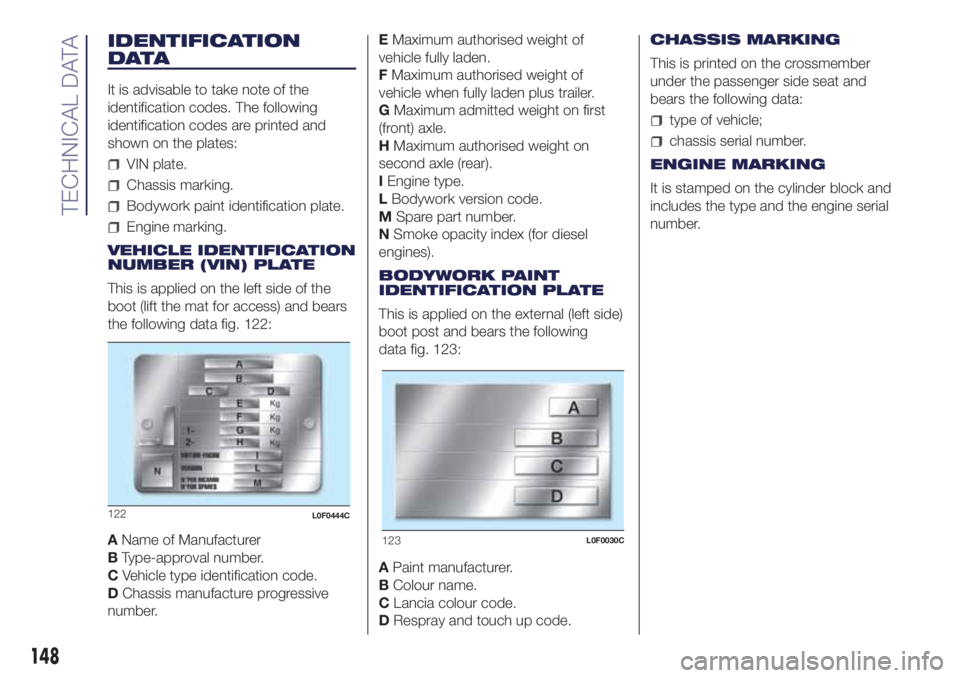
IDENTIFICATION
DATA
It is advisable to take note of the
identification codes. The following
identification codes are printed and
shown on the plates:
VIN plate.
Chassis marking.
Bodywork paint identification plate.
Engine marking.
VEHICLE IDENTIFICATION
NUMBER (VIN) PLATE
This is applied on the left side of the
boot (lift the mat for access) and bears
the following data fig. 122:
AName of Manufacturer
BType-approval number.
CVehicle type identification code.
DChassis manufacture progressive
number.EMaximum authorised weight of
vehicle fully laden.
FMaximum authorised weight of
vehicle when fully laden plus trailer.
GMaximum admitted weight on first
(front) axle.
HMaximum authorised weight on
second axle (rear).
IEngine type.
LBodywork version code.
MSpare part number.
NSmoke opacity index (for diesel
engines).
BODYWORK PAINT
IDENTIFICATION PLATE
This is applied on the external (left side)
boot post and bears the following
data fig. 123:
APaint manufacturer.
BColour name.
CLancia colour code.
DRespray and touch up code.CHASSIS MARKING
This is printed on the crossmember
under the passenger side seat and
bears the following data:
type of vehicle;
chassis serial number.
ENGINE MARKING
It is stamped on the cylinder block and
includes the type and the engine serial
number.
123L0F0030C
148
TECHNICAL DATA
122L0F0444C
Page 151 of 200

ENGINE
Versions
0.9 TwinAir 80 HP(*)0.9 TwinAir 85 HP
Engine code 312A5000 312A2000
Cycle Otto Otto
Number and position of cylinders 2 in line 2 in line
Piston bore and stroke (mm) 80.5 Ă— 86.0 80.5 Ă— 86.0
Total displacement (cmÂł) 875 875
Compression ratio 10 10
Maximum power (EEC) (kW) 59
62.5/57
(**)
Maximum power (EEC) (HP) 80
85/77.5(**)
corresponding engine speed (rpm) 5500 5500
Maximum torque (EEC) (Nm) 145
145/100
(**)
Maximum torque (EEC) (kgm) 14.8
14.8/10.2(**)
corresponding engine speed (rpm) 1900
1900/2000(**)
Spark plugs NGK PLKR9C8 NGK PLKR9C8
FuelUnleaded petrol 95 R.O.N. (EN228
specifications)Unleaded petrol 95 R.O.N. (EN228
specifications)
(*) For versions/markets, where provided
(**) With ECO button pressed
149
Page 152 of 200
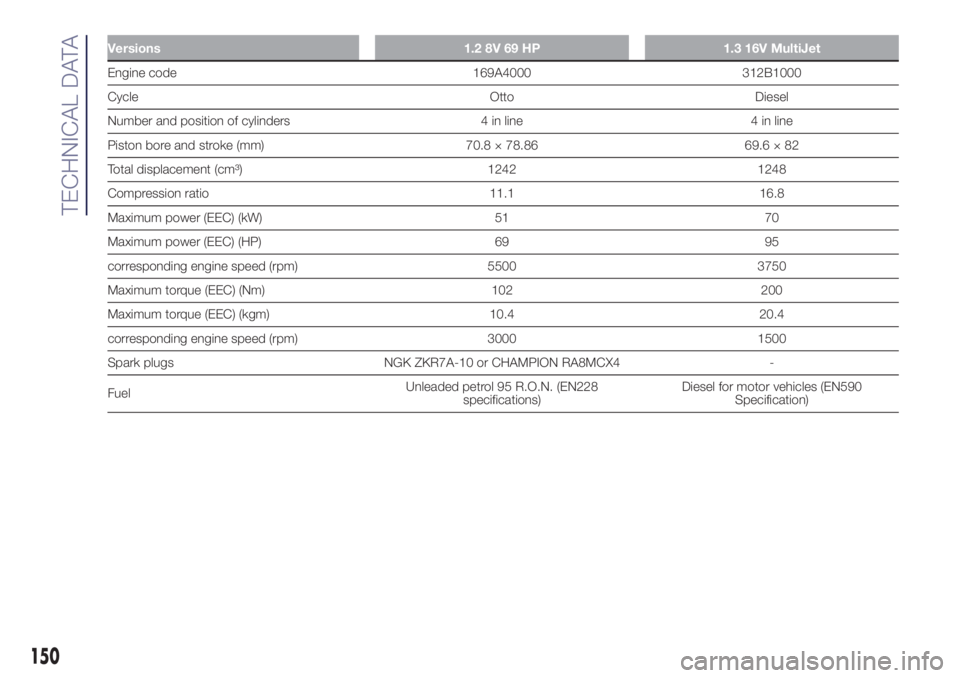
Versions 1.2 8V 69 HP 1.3 16V MultiJet
Engine code 169A4000 312B1000
Cycle Otto Diesel
Number and position of cylinders 4 in line 4 in line
Piston bore and stroke (mm) 70.8 Ă— 78.86 69.6 Ă— 82
Total displacement (cmÂł) 1242 1248
Compression ratio 11.1 16.8
Maximum power (EEC) (kW) 51 70
Maximum power (EEC) (HP) 69 95
corresponding engine speed (rpm) 5500 3750
Maximum torque (EEC) (Nm) 102 200
Maximum torque (EEC) (kgm) 10.4 20.4
corresponding engine speed (rpm) 3000 1500
Spark plugs NGK ZKR7A-10 or CHAMPION RA8MCX4 -
FuelUnleaded petrol 95 R.O.N. (EN228
specifications)Diesel for motor vehicles (EN590
Specification)
150
TECHNICAL DATA
Page 153 of 200

Versions 0.9 TwinAir Turbo Natural Power 1.2 8V 69 HP LPG
Engine code 312A2000 169A4000
Cycle Otto Otto
Number and position of cylinders 2 in line 4 in line
Piston bore and stroke (mm) 80.5 Ă— 86.0 70.8 Ă— 78.86
Total displacement (cmÂł) 875 1242
Compression ratio 10 11.1
Methane Petrol LPG Petrol
Maximum power (EEC) (kW) 59 62.5 51 51
Maximum power (EEC) (HP) 80 85 69 69
corresponding engine speed (rpm) 5500 5500 5500 5500
Maximum torque (EEC) (Nm) 140 145 102 102
Maximum torque (EEC) (kgm) 14.3 14.8 10.4 10.4
corresponding engine speed (rpm) 2500 1900 3000 3000
Spark plugs NGK PLKR9C8 NGK ZKR7AI-8
FuelMethane for motor
vehiclesUnleaded petrol 95
R.O.N. (EN228
specifications)LPG for motor
vehicles (EN589
Specification)Unleaded petrol 95
R.O.N. (EN228
specifications)
151
Page 158 of 200
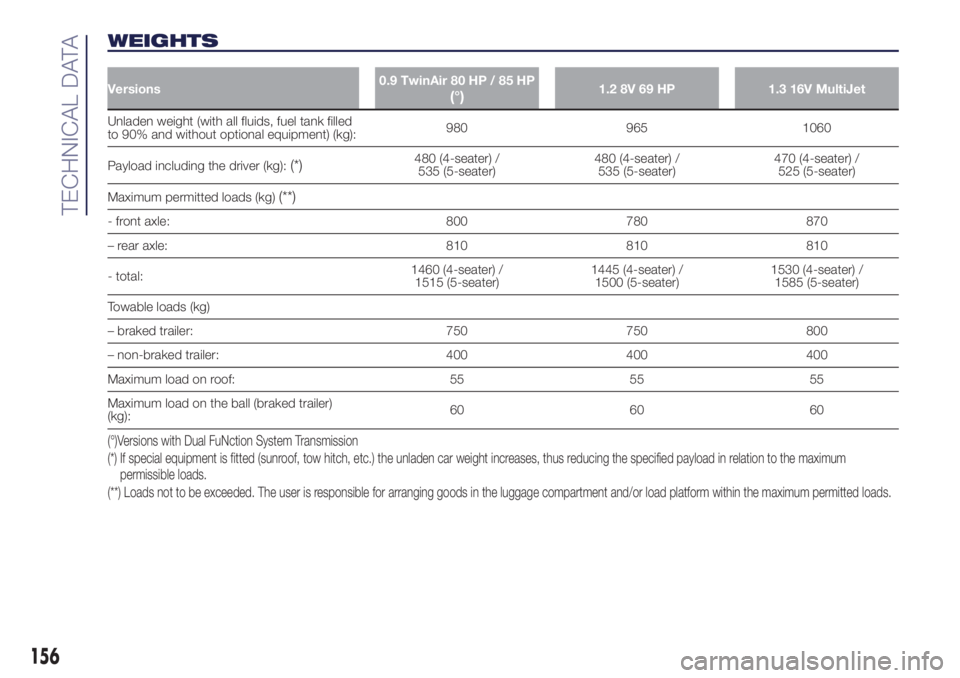
WEIGHTS
Versions0.9 TwinAir 80 HP / 85 HP(°)1.2 8V 69 HP 1.3 16V MultiJet
Unladen weight (with all fluids, fuel tank filled
to 90% and without optional equipment) (kg):980 965 1060
Payload including the driver (kg):
(*)480 (4-seater) /
535 (5-seater)480 (4-seater) /
535 (5-seater)470 (4-seater) /
525 (5-seater)
Maximum permitted loads (kg)
(**)
- front axle: 800 780 870
– rear axle: 810 810 810
- total:1460 (4-seater) /
1515 (5-seater)1445 (4-seater) /
1500 (5-seater)1530 (4-seater) /
1585 (5-seater)
Towable loads (kg)
– braked trailer: 750 750 800
– non-braked trailer: 400 400 400
Maximum load on roof: 55 55 55
Maximum load on the ball (braked trailer)
(kg):60 60 60
(°)Versions with Dual FuNction System Transmission
(*) If special equipment is fitted (sunroof, tow hitch, etc.) the unladen car weight increases, thus reducing the specified payload in relation to themaximum
permissible loads.
(**) Loads not to be exceeded. The user is responsible for arranging goods in the luggage compartment and/or load platform within the maximum permitted loads.
156
TECHNICAL DATA
Page 159 of 200

Versions 0.9 TwinAir Turbo Natural Power 1.2 8V 69 HP LPG
Unladen weight (with all fluids, fuel tank filled
to 90% and without optional equipment) (kg):1090 965
Payload including the driver (kg):
(*)450 585
Maximum permitted loads (kg)
(**)
- front axle: 810 780
– rear axle: 825 810
- total: 1540 1550
Towable loads (kg)
– braked trailer:
(***) (***)
– non-braked trailer:(***) (***)
Maximum load on roof: 55 55
Maximum load on the ball (braked trailer)
(kg):
(***) (***)
(*) If special equipment is fitted (sunroof, tow hitch, etc.) the unladen car weight increases, thus reducing the specified payload in relation to themaximum
permissible loads.
(**) Loads not to be exceeded. The user is responsible for arranging goods in the luggage compartment and/or on the load platform within the maximum permitted
loads.
(***) IMPORTANT A trailer cannot be towed so there are no provisions for fitting a tow hook.
157
Page 168 of 200

PRESCRIPTIONS FOR HANDLING THE VEHICLE AT THE END OF
ITS LIFE
FCA has been committed for many years to safeguarding the environment through the constant improvement of its production
processes and manufacturing products that are increasingly "eco-compatible". To grant customers the best possible service
in terms of respecting environmental laws and in response to European Directive 2000/53/EC governing vehicles at the end of
their life, FCA is offering its customers the chance to hand over their vehicle at the end of its life without incurring any additional
costs. The European Directive sets out that when the vehicle is handed over, the last keeper or owner should not incur any
expenses as a result of it having a zero or negative market value.
To hand your vehicle over at the end of its life without extra cost, contact one of our dealerships if you are purchasing another
vehicle or an FCA-authorised collection and scrapping centre. These centres have been carefully chosen to offer high quality
service for the collection, treatment and recycling of vehicles at their end of life, respecting the surrounding environment.
You can find further information on these collection and scrapping centres either from an FCA dealership or by calling the
number in the Warranty Booklet or by consulting the websites of the various FCA brands.
166
TECHNICAL DATA
Page 170 of 200
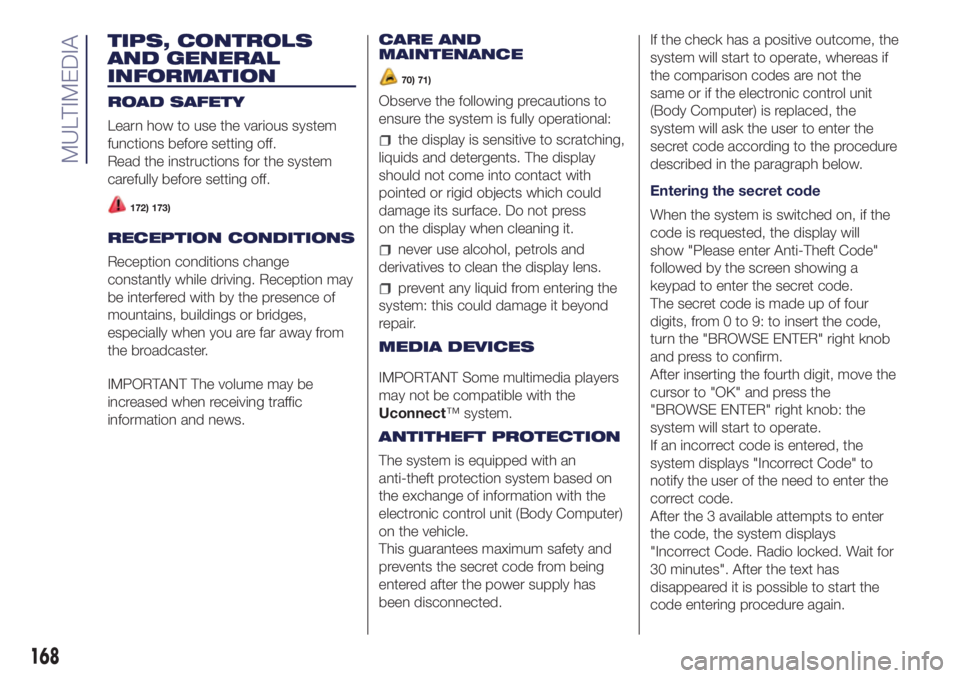
TIPS, CONTROLS
AND GENERAL
INFORMATION
ROAD SAFETY
Learn how to use the various system
functions before setting off.
Read the instructions for the system
carefully before setting off.
172) 173)
RECEPTION CONDITIONS
Reception conditions change
constantly while driving. Reception may
be interfered with by the presence of
mountains, buildings or bridges,
especially when you are far away from
the broadcaster.
IMPORTANT The volume may be
increased when receiving traffic
information and news.CARE AND
MAINTENANCE
70) 71)
Observe the following precautions to
ensure the system is fully operational:
the display is sensitive to scratching,
liquids and detergents. The display
should not come into contact with
pointed or rigid objects which could
damage its surface. Do not press
on the display when cleaning it.
never use alcohol, petrols and
derivatives to clean the display lens.
prevent any liquid from entering the
system: this could damage it beyond
repair.
MEDIA DEVICES
IMPORTANT Some multimedia players
may not be compatible with the
Uconnect™ system.
ANTITHEFT PROTECTION
The system is equipped with an
anti-theft protection system based on
the exchange of information with the
electronic control unit (Body Computer)
on the vehicle.
This guarantees maximum safety and
prevents the secret code from being
entered after the power supply has
been disconnected.If the check has a positive outcome, the
system will start to operate, whereas if
the comparison codes are not the
same or if the electronic control unit
(Body Computer) is replaced, the
system will ask the user to enter the
secret code according to the procedure
described in the paragraph below.
Entering the secret code
When the system is switched on, if the
code is requested, the display will
show "Please enter Anti-Theft Code"
followed by the screen showing a
keypad to enter the secret code.
The secret code is made up of four
digits, from 0 to 9: to insert the code,
turn the "BROWSE ENTER" right knob
and press to confirm.
After inserting the fourth digit, move the
cursor to "OK" and press the
"BROWSE ENTER" right knob: the
system will start to operate.
If an incorrect code is entered, the
system displays "Incorrect Code" to
notify the user of the need to enter the
correct code.
After the 3 available attempts to enter
the code, the system displays
"Incorrect Code. Radio locked. Wait for
30 minutes". After the text has
disappeared it is possible to start the
code entering procedure again.
168
MULTIMEDIA
Page 178 of 200
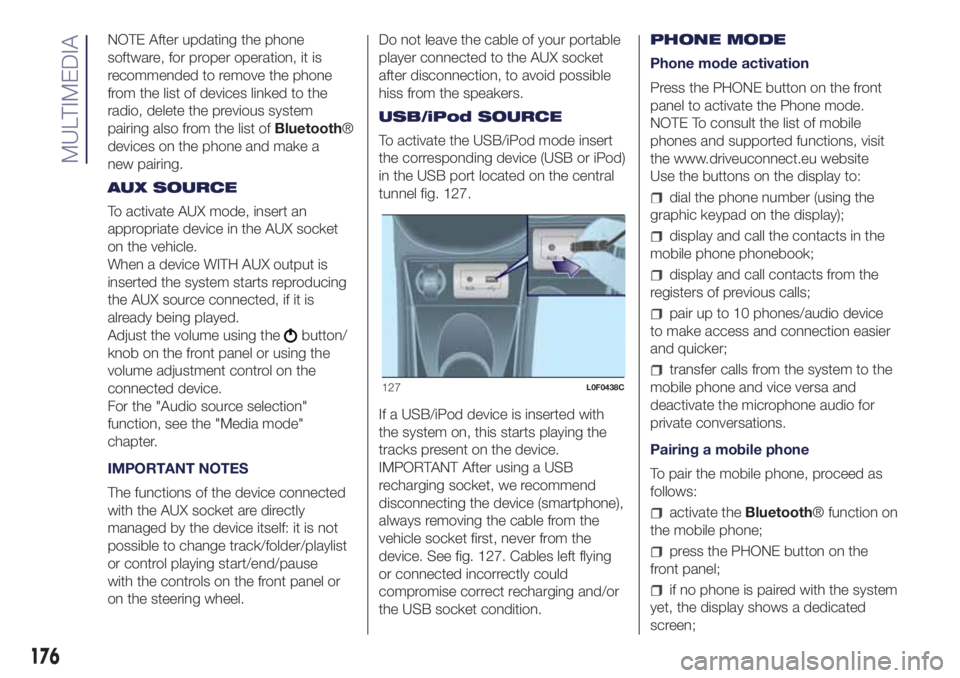
NOTE After updating the phone
software, for proper operation, it is
recommended to remove the phone
from the list of devices linked to the
radio, delete the previous system
pairing also from the list ofBluetooth®
devices on the phone and make a
new pairing.
AUX SOURCE
To activate AUX mode, insert an
appropriate device in the AUX socket
on the vehicle.
When a device WITH AUX output is
inserted the system starts reproducing
the AUX source connected, if it is
already being played.
Adjust the volume using the
button/
knob on the front panel or using the
volume adjustment control on the
connected device.
For the "Audio source selection"
function, see the "Media mode"
chapter.
IMPORTANT NOTES
The functions of the device connected
with the AUX socket are directly
managed by the device itself: it is not
possible to change track/folder/playlist
or control playing start/end/pause
with the controls on the front panel or
on the steering wheel.Do not leave the cable of your portable
player connected to the AUX socket
after disconnection, to avoid possible
hiss from the speakers.
USB/iPod SOURCE
To activate the USB/iPod mode insert
the corresponding device (USB or iPod)
in the USB port located on the central
tunnel fig. 127.
If a USB/iPod device is inserted with
the system on, this starts playing the
tracks present on the device.
IMPORTANT After using a USB
recharging socket, we recommend
disconnecting the device (smartphone),
always removing the cable from the
vehicle socket first, never from the
device. See fig. 127. Cables left flying
or connected incorrectly could
compromise correct recharging and/or
the USB socket condition.PHONE MODE
Phone mode activation
Press the PHONE button on the front
panel to activate the Phone mode.
NOTE To consult the list of mobile
phones and supported functions, visit
the www.driveuconnect.eu website
Use the buttons on the display to:
dial the phone number (using the
graphic keypad on the display);
display and call the contacts in the
mobile phone phonebook;
display and call contacts from the
registers of previous calls;
pair up to 10 phones/audio device
to make access and connection easier
and quicker;
transfer calls from the system to the
mobile phone and vice versa and
deactivate the microphone audio for
private conversations.
Pairing a mobile phone
To pair the mobile phone, proceed as
follows:
activate theBluetooth® function on
the mobile phone;
press the PHONE button on the
front panel;
if no phone is paired with the system
yet, the display shows a dedicated
screen;
127L0F0438C
176
MULTIMEDIA
Page 179 of 200
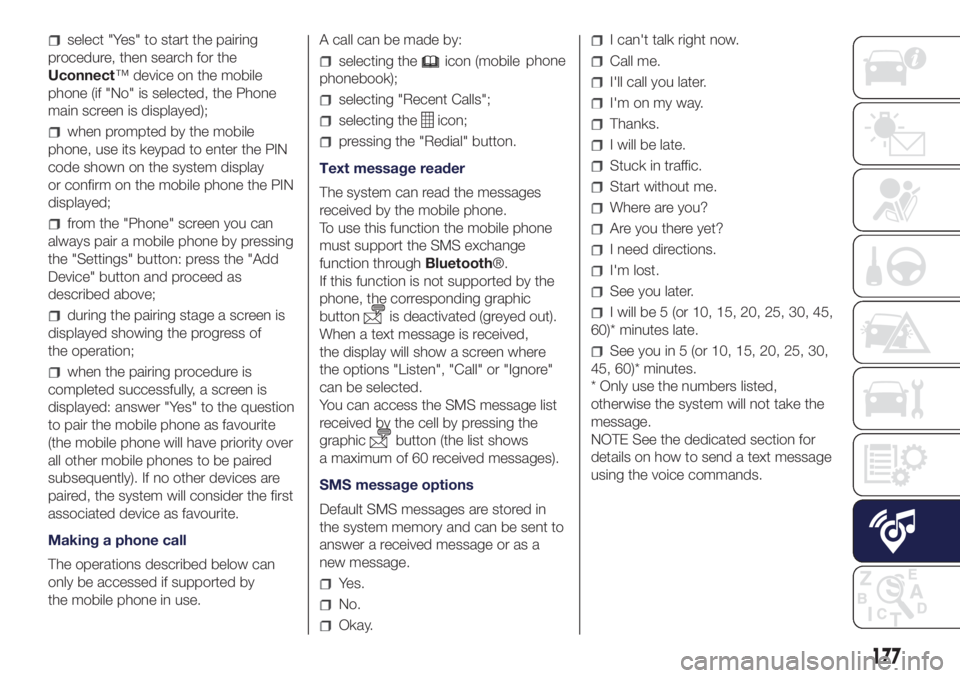
select "Yes" to start the pairing
procedure, then search for the
Uconnect™ device on the mobile
phone (if "No" is selected, the Phone
main screen is displayed);
when prompted by the mobile
phone, use its keypad to enter the PIN
code shown on the system display
or confirm on the mobile phone the PIN
displayed;
from the "Phone" screen you can
always pair a mobile phone by pressing
the "Settings" button: press the "Add
Device" button and proceed as
described above;
during the pairing stage a screen is
displayed showing the progress of
the operation;
when the pairing procedure is
completed successfully, a screen is
displayed: answer "Yes" to the question
to pair the mobile phone as favourite
(the mobile phone will have priority over
all other mobile phones to be paired
subsequently). If no other devices are
paired, the system will consider the first
associated device as favourite.
Making a phone call
The operations described below can
only be accessed if supported by
the mobile phone in use.A call can be made by:
selecting theicon (mobile
phonebook);
selecting "Recent Calls";
selecting theicon;
pressing the "Redial" button.
Text message reader
The system can read the messages
received by the mobile phone.
To use this function the mobile phone
must support the SMS exchange
function throughBluetooth®.
If this function is not supported by the
phone, the corresponding graphic
button
is deactivated (greyed out).
When a text message is received,
the display will show a screen where
the options "Listen", "Call" or "Ignore"
can be selected.
You can access the SMS message list
received by the cell by pressing the
graphic
button (the list shows
a maximum of 60 received messages).
SMS message options
Default SMS messages are stored in
the system memory and can be sent to
answer a received message or as a
new message.
Yes.
No.
Okay.
I can't talk right now.
Call me.
I'll call you later.
I'm on my way.
Thanks.
I will be late.
Stuck in traffic.
Start without me.
Where are you?
Are you there yet?
I need directions.
I'm lost.
See you later.
I will be 5 (or 10, 15, 20, 25, 30, 45,
60)* minutes late.
See you in 5 (or 10, 15, 20, 25, 30,
45, 60)* minutes.
* Only use the numbers listed,
otherwise the system will not take the
message.
NOTE See the dedicated section for
details on how to send a text message
using the voice commands.
177
phone